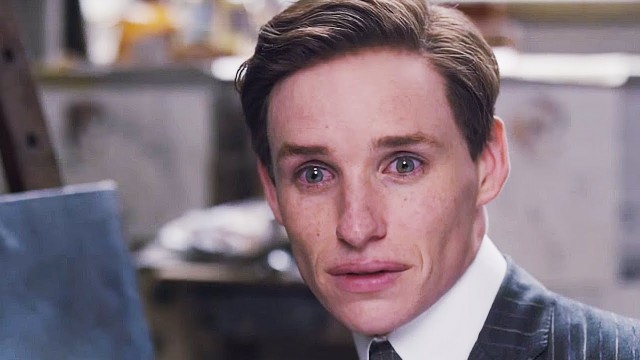There is no easy way to review The Danish Girl, a handsomely-framed travesty that seems to have escaped from the 1980’s. Perhaps, the most telling sign that this is a bad movie, along many of the same condescending lines as The Imitation Game, is the end title card. This movie, a heavily fictionalized depiction of Lili Elbe, one of the first persons to undergo a series of sex change operations, concludes by promoting Lili’s published diary, Man Into Woman, and stating that Lili is seen as a pioneer and hero to transgendered people everywhere. Meanwhile, The Danish Girl is not actually based on those diaries, but is a condensed version of the David Ebershoff’s fictionalized novel of the same name. Being glorified fanfiction promoted as truth could be problematic enough, but there’s a lot more that’s wrong with this movie.
Lili Elbe (Eddie Redmayne) was born Einar Wegener, a Danish artist whom we first meet at a gallery opening displaying paintings from him and his wife, Gerta (Alicia Vikander). But, Einar is keeping a secret. He likes women’s clothing. He trolls the rafters of a theater company just so he can touch the luxurious costumes. Basically, Einar starts out the movie as Ed Wood, just as he’s discovering his affinity for Angora sweaters.
After Gerta is shot down by an art dealer for making mundane portraits, she exacts her revenge on Einar by making him wear stockings and heeled ballet shoes when her model doesn’t show up. Content that he hasn’t been humiliated enough for her liking, she makes him hold up the ballet dress to his distress. As is the case with slashfic, Einar falls in love with women’s clothing to the point that he secretly wears Gerta’s nightgowns underneath his clothing to parties. And, of course, they fuck because wearing secret clothing sexually excites him. Then, they decide to go to a party with Einar in women’s clothing posing as Lili, inducing a “How to be a woman” training montage.
Now that the humiliation aspect is over, Einar starts having nose bleeds, dizzy spells and headaches whenever he dresses as a woman. Einar’s first symptom of illness comes right when he’s making out with a fellow artist, as Lili. Without irony, director Tom Hooper and Lucinda Coxon continue to conflate transsexualism with some sort of bodily illness even as they criticize the doctors who try to cure Lili’s disease with radiation. Even more alarming is their confusion of transsexualism with multiple personality disorder, where Lili takes over Einar’s mind, not unlike Zuul taking over Dana Barrett. At one point, Lili tells Gerta that she can’t bring Einar back right now, and then takes off her wig and becomes Einar again. Sadly, she doesn’t say “There is no Einar, only Lili,” and Gerta does not comment on Einar’s singing voice at any point in the movie.
To be perfectly honest, I’m not being entirely fair here. Lili wrote about herself in the third person quite frequently, believing Einar and Lili to be two distinct personalities. Einar was a landscape painter. Lili was a frivolous shop girl obsessed with babies. The two characters were written about with an almost schizophrenic break between the two halves of the character. Although Lili’s writing supposes a split between the two personalities to draw the distinctness of gender roles back in the day, one could hypothesize that reality was a bit more fluid.
Even though I’ve spent most of this review talking about Hooper’s problems with Lili, the movie is just as much about Gerta. Gerta and both Einar and Lili operate on opposite wavelengths; when Gerta is unhappy, Lili is ecstatic, and when Lili is ecstatic, Gerta is depressed. Gerta’s distress at Lili’s departure from their marriage is visually drawn by a freaking curtain bisecting their marital bed as they touch hands through the translucent fabric (No, I’m not kidding. This is a movie that ends with a scarf being carried by the wind). Gerta is a dedicated wife and constantly sacrifices herself for Lili at every turn; after all, Lili is the monster that Gerta created (even though Lili says that she was always there, I’m not so sure that either Hooper or Coxon believe that). When they move to France, Gerta hooks Lili up with the doctor who conducts the operation.
Accenting this ball of shit is Tom Hooper’s direction. When Eddie Redmayne has an extended single-shot where his forced smile dissolves into fearful sobs, you can practically see him writing his Oscar speech in his head. By turning in a subtler performance, Alicia Vikander comes out stronger…though even she gets her sobbing in the rain scenes. Hooper and cinematographer Danny Cohen accent this with all of Hooper’s worst traits, mimicking film 101 framing lessons (he really loves slamming actors to extreme edges of the frame), or using hilariously obvious symbolisn like shrouding Einar in a bunch of frilly lampshades. Perhaps the most damning element to the film is composer Alexandre Desplat’s attempt to mimic Phillip Glass’s frenetic repetition, actively adding to the idea that transsexualism is pure insanity and Einar is losing his damned mind by turning into Lili.
In short, this is a stupid movie and I feel dumber for having watched it. It offers no insight into a real life person, no understanding of the transsexual population, and no talent behind the camera. I award it no points, and may God have mercy on its soul.
Go watch Tangerine instead.

